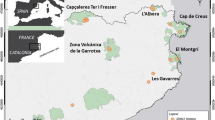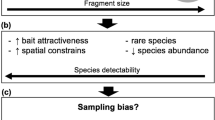Abstract
Understanding the efficacy of various types of traps is important in the design of field studies. Surprisingly, few studies have compared the relative efficacy of different types of commercially manufactured live-traps for capturing small mammals. I compared the performance of Longworth, Sherman, and Ugglan small mammal live-traps in Nearctic boreal forests. All three trap types were simultaneously set at 275 trapping stations, and animals were provided a choice of traps to enter. Number, sex, and age class of captures as well as mortality and recapture rates were compared among trap types. Captures were dominated (87 %) by red-backed voles (Myodes rutilus). Sherman traps captured significantly fewer animals than did either Longworth or Ugglan traps, but there was no difference in the sex or age class of individuals captured among trap types. Percent of mortalities varied by trap type, with the highest percentage of mortalities occurring in Sherman traps. Red-backed voles captured in Sherman traps had a significantly higher likelihood of not being recaptured again in a Sherman trap. Overall, this study found that Longworth and Ugglan traps performed similarly with respect to capturing red-backed voles and deer mice (Peromyscus spp.) in boreal forest. Sherman traps, however, were not as efficient. This difference may be particularly significant for studies relying on mark-recapture data. The relative efficacy of different trap types is likely species- and habitat-specific, and further studies in different environments are necessary. These data may assist researchers in making objective choices of which type of live-trap to employ in their research and in critically comparing results from studies using different trap types.


Similar content being viewed by others
References
Anthony NM, Ribic CA, Bautz R, Garland T (2005) Comparative effectiveness of Longworth and Sherman live traps. Wildl Soc Bull 33:1018–1025
Astúa D, Moura RT, Grelle CEV, Fonseca MT (2006) Influence of baits, trap type and position for small mammal capture in a Brazilian lowland Atlantic forest. Bol Mus Biol Mello Leitão (N Sér) 19:31–34
Beer JR (1964) Bait preferences of some small mammals. J Mammal 45:632–634
Boonstra R, Krebs CJ (1976) The effect of odour on trap response in Microtus townsendii. J Zool 180:467–476
Boonstra R, Krebs CJ (2012) Population dynamics of red-backed voles (Myodes) in North America. Oecologia 168:601–620
Boonstra R, Rodd FH (1982) Another potential bias in the use of Longworth traps. J Mammal 63:672–675
Boonstra R, Rodd FH (1984) Efficiency of pitfalls versus live traps in enumeration of populations of Microtus pennsylvanicus. Can J Zool 62:758–765
Boonstra R, Krebs CJ (2006) Population limitation of the northern red-backed vole in the boreal forests of northern Canada. J Mammal 75:1269–1284
Caceres NC, Napoli RP, Hannibal W (2011) Differential trapping success for small mammals using pitfall and standard cage traps in a woodland savannah region of southwestern Brazil. Mammalia 75:45–52
Chitty D, Kempson DA (1949) Prebaiting small mammals and a new design of live trap. Ecology 30:536–542
Dalby PL, Straney O (1976) The relative effectiveness of two sizes of Sherman live traps. Acta Theriol 21:311–313
Dizney L, Jones PD, Ruedas LA (2008) Efficacy of three types of live traps used for surveying small mammals in the Pacific Northwest. Northwest Nat 89:171–180
Do R, Shonfield J, McAdam AG (2013) Reducing accidental shrew mortality associated with small-mammal live-trapping II: a field experiment with bait supplementation. J Mammal 94:754–760
Eccard JA, Klemme I (2013) Reducing mortality of shrews in rodent live trapping—a method increasing live-trapping selectivity using shrew exits. Ann Zool Fenn 50:371–376
Evans BA (1975) Sensitizing Sherman small-mammal live traps to improve their efficiency. Northwest Sci 49:160–162
Gilbert BS, Krebs CJ (1991) Population dynamics of Clethrionomys and Peromyscus in Southwestern Yukon, 1973-1989. Holarct Ecol 14:250–259
Grant PR (1970) A potential bias in the use of Longworth traps. J Mammal 51:831–835
Hayes JP, Adam MD, Anthony RG, Witt JW (1996) Comparison of the effectiveness of Sherman and modified Fitch live-traps for capture of small mammals. Northwest Nat 77:40–43
Innes DGL, Bendall JF (1988) Sampling of small mammals by different types of traps in Northern Ontario, Canada. Acta Theriol 33:443–450
Jacob J, Ylönen H, Hodkinson CG (2002) Trapping efficiency of Ugglan traps and Longworth traps for house mice in South-Eastern Australia. Wildl Res 29:101–103
Jung TS, O’Donovan KS (2005) Mortality of deer mice, Peromyscus maniculatus, in wire mesh live-traps: a cautionary note. Can Field-Nat 119:445–446
Jung TS, Powell T (2011) Spatial distribution of meadow jumping mice (Zapus hudsonius) in logged boreal forest of Northwestern Canada. Mamm Biol 76:678–682
Kisiel DS (1972) Effect of two sizes of Sherman traps on success in trapping Peromyscus and Reithrodontomys. Am Midl Nat 87:551–552
Kok AD, Parker DM, Barker NP (2013) Rules of attraction: the role of bait in small mammal sampling at high altitude in South Africa. Afr Zool 48:84–95
Lambert TD, Malcom JR, Zimmerman BL (2005) Variation in small mammal species richness by trap height and trap type in southeastern Amazonia. J Mammal 86:982–990
Lambin X, MacKinnon J (1997) The relative efficiency of two commercial live-traps for small mammals. J Zool 242:400–404
Malcolm JR (1991) Comparative abundances of neotropical small mammals by trap height. J Mammal 72:188–192
Maly MS, Cranford JA (1985) Relative capture efficiency of large and small Sherman live traps. Acta Theriol 30:165–167
Morris RD (1968) A comparison of capture success between Sherman and Longworth live traps. Can Field-Nat 82:84–87
Nagorsen DW (2002) An identification guide to the small mammals of British Columbia. Ministry of Sustainable Resource Management, Ministry of Water, Land, and Air Protection, Biodiversity Branch, and Royal BC Museum, Victoria, British Columbia
Nelson L, Clark FW (1973) Correction for sprung traps in catch/effort calculations of trapping studies. J Mammal 54:295–298
Nicolas V, Colyn M (2006) Relative efficiency of three types of small mammal traps in an African rainforest. Belg J Zool 136:107–111
Parmenter RR, Yates TL, Anderson DR, Burnham KP, Dunnum JL, Franklin AB, Friggens MT, Lubow BC, Miller M, Olson GL, Parmenter CA, Pollard J, Rexstad E, Shenk TM, Stanley TR, White GC (2003) Small-mammal density estimation: a field comparison of grid-based vs. web-based density estimators. Ecol Monogr 73:1–26
Patric EF (1970) Bait preferences of small mammals. J Mammal 75:692–699
Pearson DE, Ruggiero LF (2003) Transects versus grid trapping arrangements for sampling small-mammal communities. Wildl Soc Bull 31:454–459
Quast JC, Howard WE (1953) Comparison of catch of two sizes of small mammal live traps. J Mammal 34:514–515
Read VT, Malafant KWJ, Myers K (1988) A comparison of grid and index-line trapping methods for small mammal surveys. Wildl Res 15:673–687
Santos-Filho M, da Silva DJ, Sanaiotti TM (2006) Efficiency of four trap types in sampling small mammals in forest fragments, Mato Grosso, Brazil. Mastozool Neotrop 13:217–225
Slade NA, Eifler MA, Gruenhagen NM, Davelos A (1993) Differential effectiveness of standard and long Sherman livetraps in capturing small mammals. J Mammal 74:156–161
Sikes RS, Gannon WL, the Animal Care and Use Committee of the American Society of Mammalogists (2011) Guidelines of the American Society of Mammalogists for the use of wild mammals in research. J Mammal 92:235–253
Soné K, Tojo H (1993) Trapping capabilities of two live-traps used on two species of field mice, Apodemus speciosus and A. argenteus. Appl Entomol Zool 28:537–545
Stoddart DM (1982) Does trap odour influence estimation of population size of the short-tailed vole, Microtus agrestis? J Anim Ecol 51:375–386
Tew T (1987) A comparison of small mammal responses to clean and dirty traps. J Zool 212:361–364
Ylönen H, Jacob J, Kotler BP (2003) Trappability of rodents in single-capture and multiple capture traps in arid and open environments: why don’t Ugglan traps work? Ann Zool Fenn 40:537–541
Wiener JG, Smith MH (1972) Relative efficiencies of four small mammal traps. J Mammal 53:868–873
Whittaker JC, Feldhamer GA, Charles EC (1998) Captures of mice, Peromyscus, in two sizes of Sherman live traps. Can Field-Nat 112:527–529
Woodman N, Timm RM, Slade NA, Doonan TJ (1996) Comparison of traps and baits for censusing small mammals in neotropical lowlands. J Mammal 77:274–281
Acknowledgments
I am indebted to Charles Krebs and Neal Dawson for loaning me traps. I am appreciative of the fine field assistance provided by Becky Cadsand, Matthias Clyde, Sara Nielsen, Kieran O’Donovan, Shannon Powell, and Kyle Russell. This work was supported by the Yukon Department of Environment.
Author information
Authors and Affiliations
Corresponding author
Additional information
Communicated by: Magdalena Niedziałkowska
Rights and permissions
About this article
Cite this article
Jung, T.S. Comparative efficacy of Longworth, Sherman, and Ugglan live-traps for capturing small mammals in the Nearctic boreal forest. Mamm Res 61, 57–64 (2016). https://doi.org/10.1007/s13364-015-0251-z
Received:
Accepted:
Published:
Issue Date:
DOI: https://doi.org/10.1007/s13364-015-0251-z




